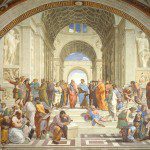
(Wikimedia Commons public domain image)
Unorganized notes from another as yet incomplete manuscript:
C. S. Lewis: “Let us suppose a race of people whose peculiar mental limitation compels them to regard a painting as something made up of little coloured dots which have been put together like a mosaic. Studying the brushwork of a great painting, through their magnifying glasses, they discover more and more complicated relations between the dots, and sort these relations out, with great toil, into certain regularities. Their labour will not be in vain. These regularities will in fact “work”: they will cover most of the facts.”[1] But, of course, a very great deal will have been missed.
As has often been observed, “Science now functions in society rather as the Church did in the Middle Ages.”[2]
As the trenchant social critic Wendell Berry has observed,
This religification or evangelizing of science, in defiance of scientific principles, is now commonplace and is widely accepted or tolerated by people who are not scientists. We really seem to have conceded to scientists, to the extent of their own regrettable willingness to occupy it, the place once occupied by the prophets and priests of religion. This can have happened only because of a general abdication of our responsibility to be critical and, above all, self-critical.[3]
Religion . . . should not attempt to dispute what science has actually proved; and science should not claim to know what it does not know; it should not confuse theory and knowledge, and it should disavow any claim on what is empirically unknowable.[4]
In shallow water one may not risk much by postulating the existence of an as yet invisible stepping stone just beneath the surface. But if the water is deep and swift, one should not start across if some of the stepping stones are hypothetical.[5]
Consilience, at any rate, shows us a man’s mind leaping with exuberant confidence from one merely conjectural stepping stone to another, oblivious of the rushing waters.[6]
[1] C. S. Lewis, Miracles: A Preliminary Study (New York: HarperSanFrancisco, 2001), 154-155.
[2] Stephen Edelglass, Georg Maier, Hans Gebert, and John Davy, The Marriage of Sense and Thought, 16. [See this]
[3] Wendell Berry, Life is a Miracle: An Essay against Modern Superstition (Washington DC: Counterpoint, 2001), 19.
[4] Wendell Berry, Life is a Miracle: An Essay against Modern Superstition (Washington DC: Counterpoint, 2001), 98.
[5] Wendell Berry, Life is a Miracle: An Essay against Modern Superstition (Washington DC: Counterpoint, 2001), 37.
[6] Wendell Berry, Life is a Miracle: An Essay against Modern Superstition (Washington DC: Counterpoint, 2001), 38.












